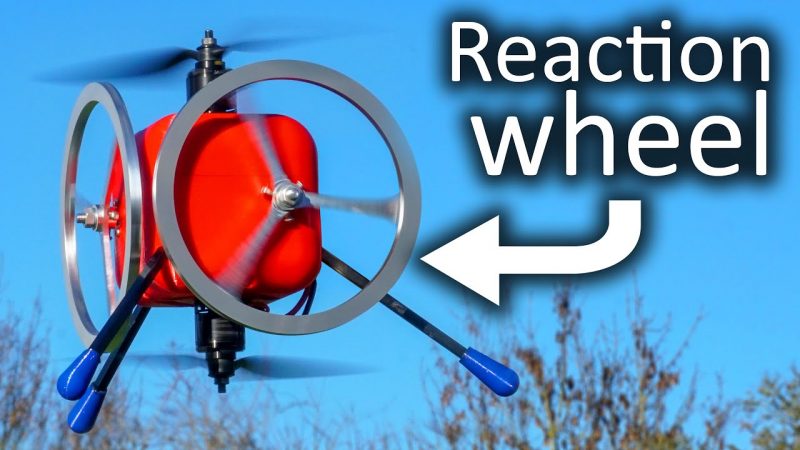When you think about all the forces that have to be balanced to keep a drone stable, it’s a wonder that the contraptions stay in the air at all. And when the only option for producing those forces is blowing around more or less air it’s natural to start looking for other, perhaps better ways to achieve flight control.
Taking a cue from the spacecraft industry, [Tom Stanton] decided to explore reaction wheels for controlling drones. The idea is simple – put a pair of relatively massive motorized wheels at right angles to each other on a drone, and use the forces they produce when they accelerate to control the drone’s pitch and roll. [Tom]’s video below gives a long and clear explanation of the physics involved before getting to the build, which results in an ungainly craft a little reminiscent of a lunar lander. The drone actually manages a few short, somewhat stable flights, but in general the reaction wheels don’t seem to be up to the task. [Tom] chalks this up to the fact that he’s using the current draw of each reaction wheel motor as a measure of its torque, which is not exactly correct for all situations. He suggests that motors with encoders might do a better job, but by the end of the video the little drone isn’t exactly in shape for continued experimentation.
Of course, dodgy reaction wheels don’t only cause problems with drones. They can also be a problem for spacecraft when the Sun gets fussy too.
Thanks for the tip, [baldpower].

















Query: would Hall-Effect Sensors on each wheel encode the necessary control. Come now….let’s get this done.
Interesting idea/build. The reactions wheels must couple with each other as well as with the propellers. I’m thinking the gyroscopic action of each reaction wheel causing torque in the vertical (propeller) axis. The flight controller/IMU works to control this but unless perfectly balanced out by the counter rotating props, the rotating reaction wheels would impart torque in the horizontal plane, offset by 90 degrees.
Done properly, might need to account for these effects that depend on the speed of the wheels.
The speed of the wheel doesn’t change the outcome much unless it’s really slow. It just approaches the perfect 90 degree angle for the force the faster it goes.
He shouldn’t need to know the torque to any great extent – use an IMU and then do closed loop control via the feedback it provides. The output of the control loop will drive the reaction wheel motor direction/speed.
Exactly! He could also enhance the aerodynamic efficienty of the thing by making it elongated and getting rid of the edges. The airflow on thet thing is a disaster and might contribute to problems. Also the wheels might be deflecting the airflow, further complicating matters. It should be cigar shaped.
And it should have a pair of aerofoils extending from its sides, and maybe some kind of drag on both horizontal and vertical axes. Maybe he could alter the shape of these aerofoils with wiggly flaps. And he could change the direction of the drag at the back by moving those in the airflow.
It sounded like that’s what he was trying to do, to use the IMU in the flight controller to sense the change and provide the control to the appropriate reaction wheel.
But just trying to ramp up the speed on the reaction wheel to counter what the IMU is detecting is not working.
It sounds to me like he’s not sure if it the non-linearity in the system or an issue with the motors. So he wants to detect the speed of the wheels to deal with those potential issues independent of the motor and maybe the alternative input will work better with the flight controller.
I wonder if there is a way he could get the drone in a test stand rather than let it destroy itself as well as be able to better measure the behavior of the reaction wheels.
Loved this.
I think that he doesn’t need the feedback but should add a learning look up table of current (I that is, not this moment in time :)) values versus revs for a specific correction and go from there.
It looks like it is quite close, with further tuning it may be able to work. I fear the bandwidth of the reaction wheels may be quite low…
He doesn’t have the torque physics right. The wheels need to torque the center of rotation, and without moment arms because accelerating one while another is turning will cause a torque on the third axis. With wheels in pairs on both sides (with a shaft or dual motors) and reworking the control to account for the flywheel torque, maybe. Otherwise it might do OK if each wheel is stopped when the other is spinning, which kind of defeats the purpose.
This is happening now when one of them is spinning https://www.youtube.com/watch?v=8H98BgRzpOM
What ever you do….don’t feed it after midnight. Seriously though, have fun and be safe….interesting…the hall effects sensor or equivalent and Mouses and Trackballs. Action = reference points?